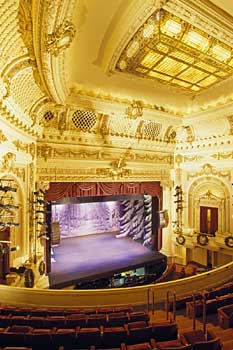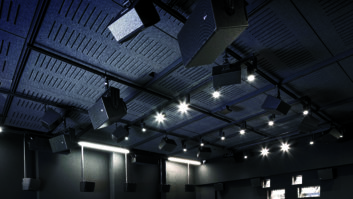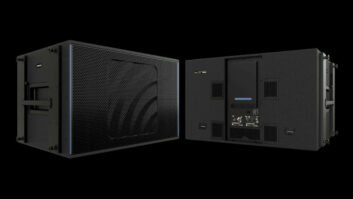
The resurrection of the Pantages Theatre (Tacoma, Wash.) was recently crowned by Federal Way, Wash.-based Point Source Inc.’s installation of a revamped audio system built around Meyer Sound’s self-powered M’elodie™ ultracompact high-power curvilinear array loudspeaker.
“The theater’s board of directors placed a priority on achieving high-quality sound and good coverage with minimal visibility,” says Point Source’s Curt Hare. “I brought in four M’elodie cabinets, stacked them up onstage and played a CD through them. That was all they needed to hear. When I showed them how the M’elodie’s self-powered design would allow them to expand the system in the future, they were even more impressed. Then they checked with the engineers for a few of the artists scheduled to perform in the coming months and got an overwhelmingly positive response, saying they’d be more than happy to see Meyer speakers in the house.”
The main portion of the Pantages’ new system comprises two arrays of eight M’elodie cabinets per side. “We typically fly all eight boxes,” explains Scott Painter, the Pantages’ production stage manager, “but we can easily split the arrays in half, groundstacking four on either side of the proscenium and flying the other four just off the top of it. With the wide range of programs we host, that flexibility is invaluable. The M’elodie is small enough that four of them on top are covered by the valances and the floor stack is covered by the borders. They’re practically invisible.”
Four UPM-1P ultracompact wide-coverage loudspeakers are used for frontfill, while a pair of 600-HP compact high-power subwoofers covers low frequencies.
As Painter explains, aesthetics and audio performance were the two major concerns in selecting the new system: It needed to be powerful enough to provide adequate coverage, but small enough not to interfere with the hall’s classic architecture. “We have 10 resident arts organizations performing here, and each of them have their own set of priorities,” he notes. “Some, such as the ballet and the opera, don’t want to see speakers hanging at all.” The system’s design provides for the hanging arrays to be raised out of sight by chain motors when not in use.
The hall is relatively wide and shallow, with only 80 feet from the proscenium to the back wall, and the majority of systems were simply too much for the space. “Of the few systems we seriously considered, most were just too large,” Painter observes. “The M’elodie was the only system that was small enough to fit the bill, but had the power and coverage we needed.”
Using Meyer Sound’s Galileo loudspeaker-management system, the sound system can be easily configured to meet a wide range of performances. “My sound man can come in here by himself, push some buttons on the Galileo, push some buttons on the chain motors and the room is immediately tuned for different configurations,” says Painter. “We can go from what we call a high-fidelity array position to a hidden array position in less than half an hour.”
“The stage area itself is somewhat limited, and it was a challenge to find a good location for the subs,” Hare explains. “The orchestra pit has a big, open space with concrete behind it, and we needed a low-frequency configuration that would be effective in reducing that energy buildup on the stage. Using two outputs from the Galileo, we took the two 600-HPs, placed one behind the other on a platform under the pit and introduced a time delay to one box to create a cardioid response. As a result, the low-frequency content onstage is far less than that in the house.”
“We had Joan Baez in recently,” says Painter. “That was challenging, in a way, because she’s got such a distinctive voice, and everyone knows what she’s supposed to sound like, so it’s difficult to be perfect. But we did it—it sounded like the words were coming right out of her mouth, not projected out of speakers. The M’elodie has such great imaging quality, it sounds like it’s not there at all.
“The M’elodie is ideally suited for the Pantages,” he concludes. “It’s truly versatile; it’s not just a rock system. We can use it in any of several configurations, depending on the demands of the production, and they sound amazing.”
For more information, visit Meyer Sound at www.meyersound.com. For additional SR news, visit The Briefing Room.






